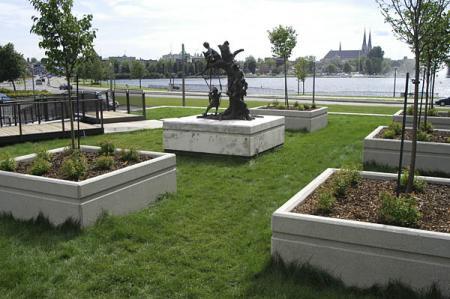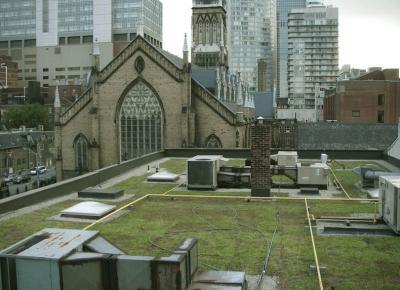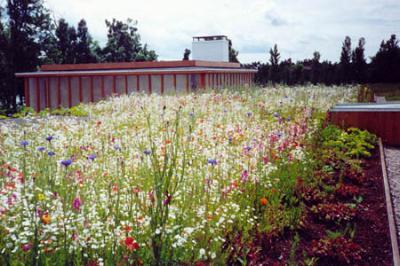Urban centres embrace the benefits of green roof technology
By Susan Hirshorn
 | |
| An intensive green roof transforms a bleak water filtration system in Salaberry-de-Valleyfield (near Montreal) into a verdant public park. | |
 |
Now Magazine is a weekly paper featuring news and entertainment in Toronto. Its offices are located in a historical building in the city core that dates back to the 1840s. In warm weather, heat from the building's tar and gravel roof made the top-floor work areas uncomfortable, even with air conditioning. The company approached green roof specialist Elevated Landscape Technologies Inc. (ELT), of Brantford, Ont., to help solve the problem.
Green roofs are known to reduce summertime roof temperatures along with the urban heat-island effect caused by a city's many heat-absorbing surfaces. A green roof replaces the vegetated footprint that is destroyed when a building is constructed. It's an extension of the existing roof, with the installation of a waterproofing and root-repellant system, a drainage system, a filter cloth, growing medium and plants.
But when ELT reviewed an engineering report about Now's roof, "it was clear they were really limited in what they could put up there," says ELT spokesman Justin Lefebvre. "Their roof couldn't support even our basic ultra-lightweight system, so we needed to customize it for them."
ELT has developed a system of inter-locking green roof panels that reduce roof load and installation time. The panels consist of a high-density polyethylene water drainage and retention carrier, a hemp capillarity blanket, a growing medium with high mineral content and drought-resistant plants. The panels are placed over a membrane made of EPDM (ethylene propylene diene monomer) rubber — a material often used for weather stripping and pond liners. "Usually our depth of growing medium would be one-and-a-half to four inches, but in this case we used less than one-and-a-half in order to lighten the load on the roof," Lefebvre explains.
The system's panels were pre-vegetated with several varieties of three-inch Sedum grown at the firm's Brantford farm. In two days the roof was transformed into a lush landscape, much to the relief of Now's heat-weary employees.
Growing awareness
Although green roofs have been a mainstay in Europe (especially in Germany) for decades, it is only within the last five years that they've gained popularity in North America. For example, a 2006 report from the industry association Green Roofs for Healthy Cities, states that 2.5 million square feet of green roofs were installed in North America in 2005. This represents an increase of over 80 per cent from 2004, the report said.
Innovative technology, such as modular pre-grown systems, are making green roofs more marketable because they require less expertise to install and provide more immediate environmental benefits than systems comprised of individual components and non-mature plants.
Another boost to the green roof market is recognition from the burgeoning green architecture movement. LEED (Leadership in Energy and Environmental Design) – a program of the Canadian and U.S. Green Building Councils which certifies buildings as environmentally sustainable — awards credits for green roof installations.
 | |
| An irrigation system ensures a good start to this green roof on the Now publishing building in Toronto. |
|
 | |
| This award-winning, 1,700 square foot green roof tops a single-family home on one of the Thousand Islands in the St. Lawrence River. Designed by Marie-Anne Bovin, a Quebec City agronomist, it uses Soprema, Canada's 'Sopranature' green roof system. The plant list is a mix of wildflower meadow and local indigenous flowers. |
Green roofs may lower heating costs in winter. A group of researchers headed by Karen Liu of the National Research Council of Canada's Institute for Research found that winter green roofs could reduce the energy used for heating. In the test house that is used as the National Research Council of Canada's field roofing facility in Ottawa, results showed that heating was reduced by more than 10 per cent during the cold season.
Plants improve air quality by trapping pollutants, while adding oxygen to our urban environments. As well, green roofs absorb storm water and release it slowly over a period of several hours. This is important because rapid runoff from roof surfaces can exacerbate flooding and increase erosion. A large amount of runoff also results in a greater quantity of water that must be treated before it is potable. According to Michigan State University's Department of Horticulture, green roof systems have been shown to retain 60 to 100 per cent of the storm water they receive.
With growing concern over urban heat, rising energy costs, flooding and pollution, local governments have been developing various policies and financial incentives to encourage green roof installation. Chicago, Portland, Ore., and Toronto have taken the lead in these activities. The result is an explosion of green roofs in these cities — on everything from schools and hospitals to commercial buildings and residences.
Interest is spreading
In Quebec, experimental green roofs are being developed by neighbourhood organizations such as the Montreal Urban Ecology Centre. The first city-owned green roof in Montreal will soon be unveiled on a community centre. And, the Energy Efficiency Fund (EEF) is offering a rebate of $5 per square foot toward creating a green roof in an urban setting. The offer is open to Gaz Métro customers whose principal source of heating is natural gas.
In Halifax, a green roof is being planned for the Patrick Power Library at St. Mary's University. The Canadian Foundation for Innovation (CFI) contributed $62,000 for the project which was matched by the Nova Scotia Research Innovation Trust Fund (NSRITF).
In British Columbia, green roof policy mechanisms are being explored by a working group established by the Centre for the Ad-vancement of Green Roof Technology, B.C. Institute of Technology. Vancouver already boasts many rooftop gardens, as well as two well-known green roofs designed by world renowned landscape designer Cornelia Hahn Oberlander. One is on Robson Square, which covers the law courts. The other tops Library Square. The 2010 Olympic Winter Games, to be held in Vancouver, are slated to have a green roof in the Olympic Village, according to the Great Lakes Water Institute.
Cost considerations
Due to the cost of installation, green roofs have only been embraced with the help of government and other funding organizations. Costs can range from $8 to $20 US per square foot, depending upon the type of green roof installed and such factors as consultant fees, structural recommendations and upgrades, irrigation system, plants and garden materials, transportation of materials and services, professional assistance and permits.
Initial maintenance and sometimes long-term maintenance costs depend on the size and type of green roof. For example, with extensive green roofs, regular maintenance is only needed for the first six to 12 months. After plants are established, watering and weeding once a season is sufficient.
An oft-touted claim is that green roofs prolong the life expectancy of a roof's membrane, thus initial costs for installation partly offset roof replacements costs. However, experts have pointed out that while the plants and other layers of the green roof assembly help protect the membrane from extreme temperatures, hailstones, foot-traffic and direct sunlight, they won't lengthen the life of a roof membrane warranted for 10 years because the chemical components of the membrane will break down after 10 years regardless.
Getting it right
Beyond the cost of installing a green roof, "fears persist about putting something on a roof that might cause leakage," says Jacob Torenvliet of Toronto's Environmental Design Landscape Contractors. "In Europe it's been proven over and over again that green roofs do not jeopardize the waterproofing membrane. It's really a function of knowing what you're doing."
Torenvliet distributes and installs ZinCo green roof systems, which are well known in Germany. Among their projects is a green roof on a four-storey apartment complex and parking garage in Toronto. "The important thing about waterproofing is taking care of the details," he says. "For instance, the membrane needs to be raised high enough so that it's at least 15 cm above the green roof surface on the entire perimeter. There also needs to be proper flashing installed over top of the membrane where it's exposed. What you find at times is that the membrane wasn't raised high enough or the flashing doesn't cover it well enough."
A green roof's horticultural system certainly demands attention to detail. Whether it thrives or fails depends on the successful interaction of climate and microclimate, sun exposure, soil and water requirements and maintenance, says Marie-Anne Boivin, an agronomist and green roof consultant based in Quebec City. "A common problem is choosing the right plants and the right thickness of growing medium for the building's hardiness zone."
Since 2002 Boivin has been responsible for the development and implementation of the Sopranature green roofing system from Soprema Canada. She has consulted on about 200 green roof projects across the country, including an award-winning private residence, a geriatric hospital and a municipal water filtration station that now doubles as a public park.
Several years ago Boivin and researchers Marie-Pierre Lamy, Andre Gosselin and Blanche Dansereau studied the effect of three substrate depths on low-temperature injury of six herbaceous perennials installed in a Quebec City green roof system. They found that stonecrop (Sedum xhybridum) had significantly more damage at two inches of growing medium than it did at four or six inches of the same medium during two Quebec City winters. Also susceptible to freezing injury in this region at two-inch depths was bugleweed (Ajuga reptans) and creeping baby's breath (Gypsophila repens).
According to Boivin, since Canadian green roof horticulture is still in its infancy, not all nurseries are knowledgeable about the appropriate plants to install and what's required to help them thrive. As a result,"some people go on the Internet and buy something that won't survive local conditions. It's important to understand those conditions and what you need to do."
Raising the bar
In an effort to raise the bar in green roof expertise, Green Roofs for Healthy Cities is leading a process it expects will lead to minimum green roof professional standards and accreditation. "The design, installation, implementation, and maintenance of green roofs require specialized knowledge and skills," says founder and president Stephen Peck. "This knowledge provides valuable opportunities to maximize client benefits such as integrated building and site design and cost reduction. Conversely without the appropriate skills, would-be green roof practitioners could potentially deliver substandard projects to their clients and seriously damage the reputation of the green roof industry in North America."
In January 2007, 16 green roof industry professionals gathered in Toronto to decide what knowledge, skills and abilities are needed to become an Accredited Green Roof Professional (AGRP). The results of their meeting will be published as an occupational standard that will form the blueprint for further course development through 2007 and 2008, and the final accreditation examination planned for 2009, Peck says. To date, the organization has delivered introductory and advanced courses on green roof infrastructure design and installation. In the meantime, Peck and other green roof gurus have been touring extensively to raise awareness and encourage buy-in to policies and financial incentives that make green roofs happen. Now Magazine's green roof was made possible by Toronto's Green Roof Incentive Pilot Program which provided grants of $10 per square metre of eligible green roof area up to a maximum of $20,000.
Says Peck, "The landscape industry has a really important role to play in greening our cities and making them healthier. I'm not sure people are fully aware of their role in advocating for the integration of plants, not simply around buildings but as part of the fabric of buildings. We need to move in this direction and deal with the challenges coming at us. Challenges like storms, heat waves and the fact that people in many places are alienated from green. In some cities you have to walk five blocks to find a living tree. Why not put nature back into the cities?"
Susan Hirshorn is a Montreal-based writer, editor and communications consultant.